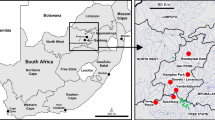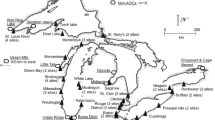Abstract
Spatial and temporal assessments and reports of polybrominated diphenyl ether (PBDE) flame retardants in birds remain sparse. In the present study, PBDEs were detected in all 120 osprey (Pandion haliaetus) eggs collected. The eggs were collected from nests along the Columbia, Willamette and Yakima rivers of Oregon (OR) and Washington (WA) and in Puget Sound (WA) between 2002 and 2007. PBDE congeners: 17, 28, 47, 49, 66, 85, 99, 100, 138, 153, 154 (possible coelution with brominated biphenyl 153 [BB153]), 183, 190 (detected in one egg), 209 (not detected), and BB101 (only detected in 2006 and 2007) and total-α-hexabromocyclododecane (only detected in five eggs) were analyzed for in the egg samples. Eggs from reservoirs in the forested headwaters of the Willamette River (2002) contained the lowest concentrations of ΣPBDEs (geometric mean [range], 98 [55.2–275] ng/g wet weight [ww]), while those from the middle Willamette River (2006) contained the highest (897 [507–1,880] ng/g ww). Concentrations in eggs from the Columbia River progressively increased downstream from Umatilla, OR (River Mile [RM] 286) to Skamokoa, WA (RM 29), which indicated additive PBDE sources along the river. In general, regardless of the year of egg collection, differences in PBDE concentrations reported in osprey eggs along the three major rivers studied (Columbia, Willamette and Yakima) seem to reflect differences in river flow (dilution effect) and the extent of human population and industry (source inputs) along the rivers. PBDE concentrations increased over time at two locations (Seattle, WA; Columbia River, RM 29-84) where temporal patterns could be evaluated. Only during 2006 (on the middle Willamette River, RM 61–157) and 2007 (on the lower Columbia River, RM 29–84) did ΣPBDE concentrations in osprey eggs exceed 1,000 ng/g ww with negative relationships indicated at both locations between productivity and ΣPBDE concentrations in eggs (P = 0.008, P = 0.057). Osprey eggs from Everett, WA contained nearly twice the ΣPBDE concentration (geometric mean 239 vs. 141 ng/g ww, range 124–384 vs. 22.2–819 ng/g ww, P ≤ 0.05) as double-crested cormorant (Phalacrocorax auritus) eggs collected at the same location and time, which is likely due to dietary differences. No significant relationship (all Ps > 0.147) was indicated between PBDE congeners (including ΣPBDEs) and eggshell thickness at the concentrations observed in this study.

Similar content being viewed by others
References
Blus LJ (1984) DDE in birds’ eggs: comparison of two methods for estimating critical levels. Wilson Bull 96:268–276
Bustness JO, Yoccoz NG, Bangjord G, Polder A, Skaare JU (2007) Temporal trends (1986–2004) of organochlorines and brominated flame retardants in tawny owl eggs from northern Europe. Environ Sci Technol 41:8491–8497. doi:10.1021/es071581w
Chen D, Mai B, Song J, Sun Q, Luo Y, Luo X, Zeng EY, Hale RC (2007) Polybrominated diphenyl ethers in birds of prey from northern China. Environ Sci Technol 41:1828–1833. doi:10.1021/es062045r
Chen D, LaGuardia MJ, Harvey E, Amaral M, Wohlfort K, Hale RC (2008) Polybrominated diphenyl ethers in peregrine falcon (Falco peregrinus) eggs from the northeastern US. Environ Sci Technol 42:7594–7600. doi:10.1021/es8010749
Darnerud PO (2003) Toxic effects of brominated flame retardants in man and wildlife. Environ Int 29:841–853. doi:10.1016/S0160-4120(03)00107-7
Darnerud PO, Eriksen GS, Jóhannesson T, Larsen PB, Viluksela M (2001) Polybrominated diphenyl ethers: occurrence, dietary exposure and toxicology. Environ Health Perspect 109(Supplement):49–68. doi:10.2307/3434846
de Wit CA (2002) An overview of brominated flame retardants in the environment. Chemosphere 46:583–624. doi:10.1016/S0045-6535(01)00225-9
Elliott JE, Wilson LK, Wakeford B (2005) Polybrominated diphenyl ether trends in eggs of aquatic and marine birds from British Columbia, Canada, 1979–2002. Environ Sci Technol 39:5584–5591. doi:10.1021/es050496q
Elliott JE, Morrissey CA, Henny CJ, Inzunza ER, Shaw P (2007) Satellite telemetry and prey sampling reveal contaminant sources to Pacific Northwest ospreys. Ecol Appl 17:1223–1233. doi:10.1890/06-1213
Fernie KJ, Shutt JL, Mayne G, Hoffman DJ, Letcher RJ, Drouillard KG, Ritchie IJ (2005) Exposure to polybrominated diphenyl ethers (PBDEs): changes in thyroid, vitamin A, glutathione homeostasis, and oxidative stress in American kestrels (Falco sparverius). Toxicol Sci 88:375–383. doi:10.1093/toxsci/kfi295
Fernie KJ, Shutt JL, Letcher RJ, Ritchie JI, Sullivan K, Bird DM (2008) Changes in reproductive courtship behaviors of adult American kestrels (Falco sparverius) exposed to environmentally relevant levels of the polybrominated diphenyl ether mixture, DE-71. Toxicol Sci 102:171–178. doi:10.1093/toxsci/kfm295
Fernie KJ, Shutt JL, Letcher RJ, Ritchie JI, Bird DM (2009) Environmentally relevant concentrations of DE-71 and HBCD alter eggshell thickness and reproductive success of American kestrels (Falco sparverius). Environ Sci Technol 43:2124–2130. doi:10.1021/es8027346
Gauthier LT, Hebert CW, Weseloh DVC, Letcher RJ (2007) Current-use flame retardants in the eggs of herring gulls (Larus argentatus) from the Laurentian Great Lakes. Environ Sci Technol 41:4561–4567. doi:10.1021/es0630487
Gauthier LT, Hebert CE, Weseloh DVC, Letcher RJ (2008) Dramatic changes in the temporal trends of polybrominated diphenyl ethers (PBDEs) in herring gull eggs from the Laurentian Great Lakes: 1982–2006. Environ Sci Technol 42:1524–1530. doi:10.1021/es702382k
Grove RA, Henny CJ, Kaiser JL (2009) Osprey: worldwide sentinel species for assessing and monitoring environmental contamination in rivers, lakes, reservoirs and estuaries. J Toxicol Environ Health Part B 12:1–20
Henny CJ, Grove RA, Kaiser JL, Bentley VR (2004) An evaluation of osprey eggs to determine spatial residue patterns and effects of contaminants along the lower Columbia River, USA. In: Chancellor RD, Meyburg B-U (eds) Raptors worldwide. WWGBP and MME, Budapest, Hungary, pp 369–388
Henny CJ, Grove RA, Kaiser JL (2008) Osprey distribution, abundance, reproductive status and contaminant burdens along lower Columbia River, 1997/1998 versus 2004. Arch Environ Contam Toxicol 54:525–534. doi:10.1007/s00244-007-9041-1
Henny CJ, Kaiser JL, Grove RA (2009) PCDDs, PCDFs, PCBs, OC pesticides and mercury in fish and osprey eggs from Willamette River, Oregon (1993, 2001 and 2006) with calculated biomagnifications factors. Ecotoxicology 18:151–173. doi:10.1007/s10646-008-0268-z
Herzke D, Berger U, Kallenborn R, Nygard T, Vetter W (2005) Brominated flame retardants and other organobromines in Norwegian predatory bird eggs. Chemosphere 61:441–449. doi:10.1016/j.chemosphere.2005.01.066
Hollander M, Wolfe DA (1973) Nonparametric statistical methods. John Wiley and Sons, New York
Janák K, Sellström U, Johannson A-K, Becher G, de Wit CA, Lindberg P, Helander B (2008) Enantiomer-specific accumulation of hexabromocyclododecanes in eggs of predatory birds. Chemosphere 73:193–200. doi:10.1016/j.chemosphere.2007.03.077
Jansson B, Andersson R, Asplund L, Litzen K, Nylund K, Sellstrom U, Uvemo UB, Wahlberg C, Wideqvst U, Odsjo T, Olsson M (1993) Chlorinated and brominated persistent organic compounds in biological samples from the environment. Environ Toxicol Chem 12:1163–1174. doi:10.1897/1552-8618(1993)12[1163:CABPOC]2.0.CO;2
Jaspers V, Covaci A, Maervoet J, Dauwe T, Voorspoels S, Schepens P, Eens M (2005) Brominated flame retardants and organochlorine pollutants in eggs of little owls (Athene noctua) from Belgium. Environ Pollut 136:81–88. doi:10.1016/j.envpol.2004.12.003
Johansson A, Sellstrom U, Lindberg P, Bignert A, DeWitt C (2009) Polybrominated diphenyl ether congener patterns, hexabromocyclododecane and brominated biphenyl 153 in eggs of peregrine falcons (Falco peregrinus) breeding in Sweden. Environ Toxicol Chem 28:9–17. doi:10.1897/08-142.1
Law RJ, Allchin CR, de Boer J, Covaci A, Herzke D, Lepom P, Morris S, Tronczynski J, de Wit CA (2006) Levels and trends of brominated flame retardants in the European environment. Chemosphere 64:187–208. doi:10.1016/j.chemosphere.2005.12.007
Lindberg P, Sellstrom U, Haggberg L, de Wit CA (2004) Higher brominated diphenyl ethers and hexabromocyclododecane found in eggs of peregrine falcons (Falco peregrinus) breeding in Sweden. Environ Sci Technol 38:93–96. doi:10.1021/es034614q
Lundstedt-Enkel K, Asplund L, Nylund K, Bignert A, Tysklind M, Olsson M, Örberg J (2006) Multivariate data analysis of organochlorines and brominated flame retardants in Baltic Sea guillemot (Uria aalge) egg and muscle. Chemosphere 65:1591–1599. doi:10.1016/j.chemosphere.2006.03.051
McKernan MA, Rattner BA, Hale RC, Ottinger MA (2009) Toxicity of polybrominated diphenyl ethers (DE-71) in chicken (Gallus gallus), mallard (Anas platyrhynchos) and American kestrel (Falco sparverius) embryos and hatchlings. Environ Toxicol Chem 28:1007–1017. doi:10.1897/08-318.1
McKinney MA, Cesh LS, Elliott JE, Williams TD, Garcelon DK, Letcher RJ (2006) Novel brominated and chlorinated contaminants and hydroxylated analogues among North American west coast populations of bald eagles (Haliaeetus leucocephalus). Environ Sci Technol 40:6275–6281. doi:10.1021/es061061l
Norstrom RJ, Simon M, Moisey J, Wakeford B, Weseloh DVC (2002) Geographical distribution (2000) and temporal trends (1981–2000) of brominated diphenyl ethers in Great Lakes herring gull eggs. Environ Sci Technol 36:4783–4789. doi:10.1021/es025831e
Postupalsky S (1977) A critical review of problems in calculating osprey reproductive success. In: Ogden JC (ed) Transactions No American Osprey Research Conference, Transaction and Proceeding Series No 2, Natl Park Serv, Washington DC, pp 1–11
Rattner BA, McGowan PC, Golden NH, Hatfield JS, Toschik PC, Lukei RF Jr, Hale RC, Schmitz-Alfonso I, Rice CP (2004) Contaminant exposure and reproductive success of osprey (Pandion haliaetus) nesting in Chesapeake Bay regions of concern. Arch Environ Contam Toxicol 47:126–140. doi:10.1007/s00244-003-3160-0
Rayne S, Ikonomou MG, Antcliffe B (2003) Rapidly increasing polybrominated diphenyl ether concentrations in the Columbia River system from 1992–2000. Environ Sci Technol 37:2847–2854. doi:10.1021/es0340073
SAS Institute (2003) SAS user’s guide: statistics, Version 9.1 Edition, SAS Institute Inc., Cary, NC
Stickel LF, Wiemeyer SN, Blus LJ (1973) Pesticide residues in eggs of wild birds: adjustment for loss of moisture and lipid. Bull Environ Contam Toxicol 9:193–196. doi:10.1007/BF01684824
Toschik PC, Rattner BA, McGowan PC, Christman MC, Carter DB, Hale RC, Matson CW, Ottinger MA (2005) Effects of contaminant exposure on reproductive success of osprey (Pandion haliaetus) nesting in Delaware River and Bay, USA. Environ Toxicol Chem 24:617–628. doi:10.1897/04-141R.1
Ucán-Marín F, Arukwe A, Mortensen A, Gabrielsen GW, Fox GA, Letcher RJ (2009) Recombinant transthyretin purification and competitive binding with organohalogen compounds in two gull species (Larus argentatus and Larus hyperboreus). Toxicol Sci 107:440–450. doi:10.1093/toxsci/kfn240
Van den Steen E, Eens M, Covaci A, Dirtu AC, Jaspers VLB, Neels H, Pinxten R (2009) An exposure study with polybrominated diphenyl ethers (PBDEs) in female European starlings (Sturnus vulgaris): toxicokinetics and reproductive effects. Environ Pollut 157:430–436. doi:10.1016/j.envpol.2008.09.031
Wiemeyer SN, Bunck CM, Krynitsky AJ (1988) Organochlorine pesticides, polychlorinated biphenyls, and mercury in osprey eggs 1970–1979 and their relationships to shell thinning and productivity. Arch Environ Contam Toxicol 17:767–787. doi:10.1007/BF01061982
Acknowledgments
We thank B. Rattner and G. Heinz for providing comments on an earlier version of this manuscript. Lewis Gauthier, Andrei Lezau and Soheila Shahmiri (NWRC, Ottawa) are also thanked for PBDE analysis. The study was funded by US Geological Survey. Any use of trade, product, or firm names is for descriptive purposes only and does not imply endorsement by the US Government.
Author information
Authors and Affiliations
Corresponding author
Rights and permissions
About this article
Cite this article
Henny, C.J., Kaiser, J.L., Grove, R.A. et al. Polybrominated diphenyl ether flame retardants in eggs may reduce reproductive success of ospreys in Oregon and Washington, USA. Ecotoxicology 18, 802–813 (2009). https://doi.org/10.1007/s10646-009-0323-4
Received:
Accepted:
Published:
Issue Date:
DOI: https://doi.org/10.1007/s10646-009-0323-4




